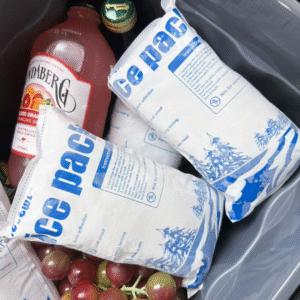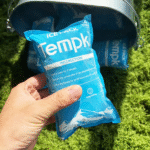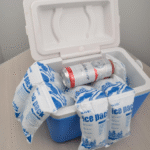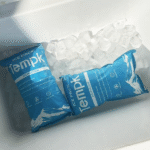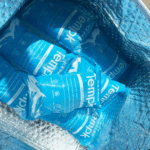Escolhendo os melhores pacotes de gelo seco & Fornecedor para remessa eficiente de cadeia de frio em 2025
Ao enviar bens sensíveis à temperatura, manter uma cadeia de frio consistente é fundamental. As bolsas de gelo seco são a solução mais confiável para preservar produtos congelados durante o transporte. Se você está enviando comida, produtos farmacêuticos, ou outros bens perecíveis, entender como escolher o fornecedor certo de gelo seco e o melhor tipo de bolsa de gelo seco pode garantir uma entrega segura e eficiente. Neste guia, cobriremos tudo, desde tipos de bolsas de gelo seco até seleção de fornecedores, considerações sobre preços, e dicas de segurança.
-
Entenda os diferentes tipos de bolsas de gelo seco e suas aplicações.
-
Saiba como selecionar o melhor fornecedor de gelo seco para suas necessidades.
-
Compare bolsas de gelo seco com outras soluções de resfriamento, como pacotes de gel e PCM.
-
Descubra como manusear com segurança, loja, e enviar com gelo seco.
-
Fique à frente das tendências do mercado e das mudanças regulatórias em 2025.
H2: O que são bolsas de gelo seco e por que são essenciais?
Bolsas de gelo seco são dióxido de carbono solidificado (Co₂) que sublimam em temperaturas ultrabaixas, tornando-os perfeitos para enviar itens congelados. Ao contrário do gelo tradicional, o gelo seco não deixa nenhum resíduo de água, garantindo que seus produtos permaneçam secos e devidamente resfriados. Esta seção detalha os principais motivos para usar gelo seco:
Benefícios das bolsas de gelo seco:
-
Resfriamento ultrafrio: O gelo seco atinge temperaturas tão baixas quanto -78,5°C, ideal para produtos que necessitam de congelamento.
-
Sem resíduos de água: Ao contrário do gelo regular, o gelo seco sublima em gás sem deixar umidade para trás, evitando danos causados pela água às mercadorias.
-
Duração de resfriamento mais longa: O gelo seco dura muito mais que o gelo, o que ajuda a reduzir o risco de variações de temperatura durante remessas longas.
H3: Como funcionam as bolsas de gelo seco?
Gelo seco sublimados, passando diretamente do sólido para o gasoso sem passar pela fase líquida. Isso o torna ideal para o transporte de mercadorias em longas distâncias, onde o resfriamento prolongado é necessário. O processo de sublimação do gelo seco garante um fornecimento constante de ar frio sem a confusão do derretimento da água. O gelo seco funciona absorvendo o calor do ambiente, manter a temperatura necessária para produtos perecíveis, e garantindo sua segurança durante o trânsito.
| Tipo de gelo seco | Duração do resfriamento | Melhor para | Aplicativos |
|---|---|---|---|
| Blocos de gelo seco | 48-72 horas | Envio de longa distância | Produtos farmacêuticos, grandes remessas de alimentos |
| Pelotas de gelo seco | 24-48 horas | Resfriamento rápido | Laboratórios, Suprimentos médicos |
| Camas de gelo seco | 12-24 horas | Pequena escala, resfriamento preciso | Embalagens de alimentos perecíveis, itens sensíveis |
H2: Como escolher o fornecedor certo de gelo seco?
Principais considerações:
Selecionar um fornecedor confiável de gelo seco é crucial para garantir que você obtenha produtos e serviços de alta qualidade que atendam às suas necessidades de remessa.. Aqui estão os principais fatores a serem considerados:
-
Qualidade do produto: Garantir que o fornecedor ofereça gelo seco de qualidade alimentar que atenda aos padrões da FDA, com pureza de CO₂ de pelo menos 99.9%.
-
Variedade de opções de embalagem: Procure fornecedores que ofereçam uma variedade de tamanhos e tipos, como blocos, Pellets, ou folhas, para atender às suas necessidades específicas.
-
Capacidades de entrega e envio: Escolha um fornecedor que possa fornecer entrega pontual com embalagens isoladas para evitar sublimação durante o transporte.
-
Suporte ao Cliente e Conformidade: Um bom fornecedor irá ajudá-lo a navegar pelos regulamentos, forneça os rótulos necessários (por exemplo, UN1845), e oferecer treinamento, se necessário.
Principais fornecedores de gelo seco a serem considerados:
-
Linde Gás – Fornecedor global com uma gama de produtos de gelo seco, entrega confiável, e envio rápido.
-
Gás aéreo – Oferece gelo seco em blocos, Pellets, e folhas com opções de entrega rápida.
-
CryoPort – Especializada em soluções personalizadas para logística sensível à temperatura, especialmente para produtos farmacêuticos.
H2: Quanto custam as bolsas de gelo seco?
O preço das bolsas de gelo seco pode variar dependendo da quantidade, tamanho, e localização. Em média, custos de gelo seco entre $1 e $3 por libra. No entanto, outros fatores, como taxas de envio e embalagem, pode adicionar ao custo total. Para reduzir despesas, considere comprar a granel, estabelecimento de contratos de longo prazo com fornecedores, e otimizar suas embalagens para minimizar o desperdício.
| Fator | Impacto nos custos | Como salvar |
|---|---|---|
| Volume e Quantidade | Pedidos em grandes quantidades geralmente reduzem o preço por libra | Compre a granel ou negocie contratos de longo prazo |
| Distância de envio | Distâncias maiores aumentam o custo | Escolha fornecedores regionais para envio mais rápido |
| Embalagem | Embalagens especiais aumentam custos | Use isolamento otimizado para reduzir perdas por sublimação |
H2: Gelo seco vs pacotes de gel vs PCM: Qual refrigerante é ideal para você?
Em 2025, várias alternativas ao gelo seco estão ganhando popularidade, incluindo pacotes de gel e materiais de mudança de fase (PCM). Aqui está uma comparação para ajudá-lo a decidir qual opção melhor atende às suas necessidades:
-
Gelo Seco: Ideal para condições ultra-frias (-78,5 ° C.), melhor para remessas de longa distância ou internacionais. Requer manuseio especial e é regulamentado como material perigoso.
-
Pacotes de gel: Melhor para itens resfriados (2° C - 8 ° C.), reutilizável, e não perigoso. Bom para remessas de curto prazo, mas pode formar condensação durante o descongelamento.
-
Materiais de mudança de fase (PCM): Opções flexíveis de temperatura (−21°C a −15°C), reutilizável até 30 ciclos, e não regulamentado. Ideal para itens sensíveis e soluções de envio sustentáveis.
| Tipo de refrigerante | Faixa de temperatura | Custo | Duração | Reutilização | Regulamentos sobre materiais perigosos |
|---|---|---|---|---|---|
| Gelo Seco | ~−78,5°C | Alto | 24-72 horas | Uso único | Sim |
| Pacotes de gel | 0° C - 8 ° C. | Baixo | 24-48 horas | Reutilizável | Não |
| PCM | −21°C a −15°C | Moderado | Até 48 horas | Reutilizável | Geralmente não |
H2: Diretrizes de segurança e armazenamento para bolsas de gelo seco
Manusear e armazenar gelo seco corretamente é essencial para evitar riscos como congelamento ou asfixia devido ao acúmulo de gás CO₂. Siga estas diretrizes para manuseio e armazenamento seguros:
-
Use equipamento de proteção: Sempre use luvas e pinças isoladas ao manusear gelo seco.
-
Armazenar em áreas ventiladas: O gelo seco deve ser armazenado em um refrigerador com aberturas para permitir que o gás CO₂ escape com segurança.
-
Evite contato com produtos: Certifique-se de que o gelo seco esteja devidamente isolado para evitar queimaduras ou danos às mercadorias.
H2: Principais tendências em logística de gelo seco e cadeia de frio para 2025
À medida que o mercado de logística da cadeia de frio continua a crescer, várias tendências estão moldando a indústria:
-
Produção Sustentável de Gelo Seco: Muitos fornecedores estão agora produzindo gelo seco a partir de CO₂ reciclado, reduzindo sua pegada de carbono.
-
Embalagem inteligente: A ascensão de sensores inteligentes e sistemas de monitoramento de temperatura permite o rastreamento em tempo real do gelo seco durante o trânsito.
-
Soluções Híbridas: A combinação de gelo seco com pacotes de gel ou PCM está se tornando uma tendência popular para otimizar a eficiência do resfriamento e, ao mesmo tempo, reduzir as emissões de CO₂.
Perguntas frequentes
Q1: Quanto tempo duram os pacotes de gelo seco?
As bolsas de gelo seco normalmente duram 18-24 horas dependendo do tamanho e isolamento. Blocos maiores duram mais.
Q2: Posso enviar gelo seco por via aérea?
Sim, gelo seco pode ser enviado por via aérea, mas regulamentos especiais devem ser seguidos, incluindo requisitos de rotulagem e embalagem.
Conclusão
Escolher os pacotes e o fornecedor de gelo seco certos é crucial para manter uma cadeia de frio confiável. Ao compreender os diferentes tipos de gelo seco, considerando fatores de custo, e aderindo aos protocolos de segurança, você pode otimizar suas operações de envio e garantir que suas mercadorias sensíveis à temperatura cheguem em perfeitas condições.
Chamado à ação:
Pronto para agilizar sua logística de cadeia de frio? Entre em contato hoje mesmo com um fornecedor confiável de gelo seco e explore as melhores soluções para as necessidades do seu negócio.
Sobre Tempk:
A Tempk é fornecedora líder de soluções sustentáveis de cadeia de frio, oferecendo produtos de gelo seco de alta qualidade e soluções personalizadas para empresas de todos os setores. Com nossa experiência em logística e controle de temperatura, garantimos a confiabilidade e segurança de suas remessas.






